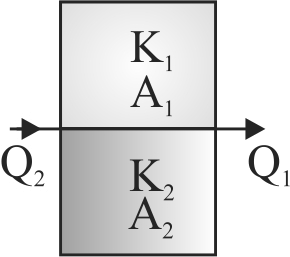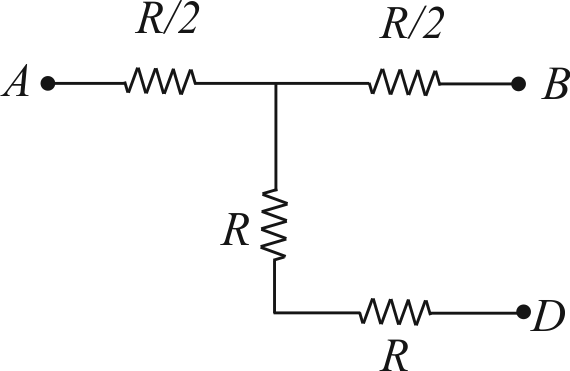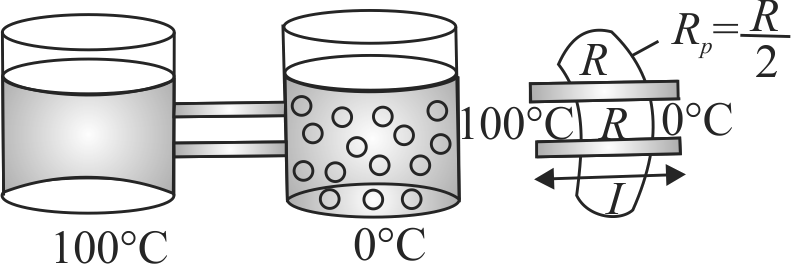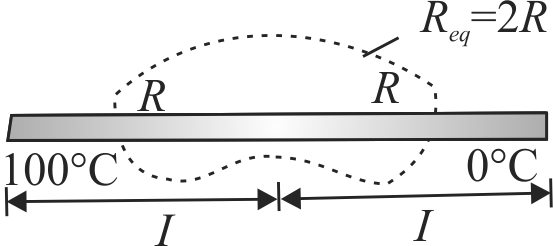366399 A cylinder of radius \(R\) made of a material of thermal conductivity \(K_{1}\) is surrounded by a cylindrical shell of inner radius \(R\) and outer radius \(2R\) made of material of thermal conductivity \(K_{2}\). The two ends of a combined system are maintained at two different temperatures. There is no loss of heat across the cylindrical surface and the system is in steady state. The effective thermal conductivity of the system is:
366400
Three rods of identical dimensions are arranged as shown.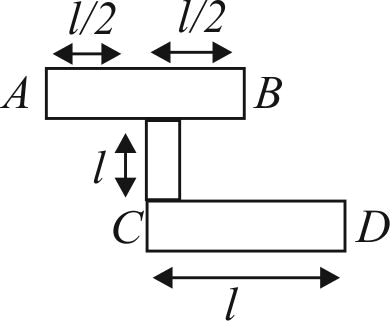
Conductivity of the material of rods is \(k,\) area of cross-section of rods is \(A,\) length of each rod is \(l\). Thermal resistance of the system between points \(A\) and \(D\) is, ( Assume there are no losses due to radiation)
366401 Two identical conducting rods are first connected independently to two vessels, one containing water at \(100^{\circ} {C}\) and the other containing ice at \(0^{\circ} {C}\). In the second case, the rods are joined end to end and connected to the same vessels. Let \(q_{1}\) and \(q_{2} {~g} / {s}\) be the rate of melting of ice in two cases respectively. The ratio of \(q_{1} / q_{2}\) is
366399 A cylinder of radius \(R\) made of a material of thermal conductivity \(K_{1}\) is surrounded by a cylindrical shell of inner radius \(R\) and outer radius \(2R\) made of material of thermal conductivity \(K_{2}\). The two ends of a combined system are maintained at two different temperatures. There is no loss of heat across the cylindrical surface and the system is in steady state. The effective thermal conductivity of the system is:
366400
Three rods of identical dimensions are arranged as shown.
Conductivity of the material of rods is \(k,\) area of cross-section of rods is \(A,\) length of each rod is \(l\). Thermal resistance of the system between points \(A\) and \(D\) is, ( Assume there are no losses due to radiation)
366401 Two identical conducting rods are first connected independently to two vessels, one containing water at \(100^{\circ} {C}\) and the other containing ice at \(0^{\circ} {C}\). In the second case, the rods are joined end to end and connected to the same vessels. Let \(q_{1}\) and \(q_{2} {~g} / {s}\) be the rate of melting of ice in two cases respectively. The ratio of \(q_{1} / q_{2}\) is
366399 A cylinder of radius \(R\) made of a material of thermal conductivity \(K_{1}\) is surrounded by a cylindrical shell of inner radius \(R\) and outer radius \(2R\) made of material of thermal conductivity \(K_{2}\). The two ends of a combined system are maintained at two different temperatures. There is no loss of heat across the cylindrical surface and the system is in steady state. The effective thermal conductivity of the system is:
366400
Three rods of identical dimensions are arranged as shown.
Conductivity of the material of rods is \(k,\) area of cross-section of rods is \(A,\) length of each rod is \(l\). Thermal resistance of the system between points \(A\) and \(D\) is, ( Assume there are no losses due to radiation)
366401 Two identical conducting rods are first connected independently to two vessels, one containing water at \(100^{\circ} {C}\) and the other containing ice at \(0^{\circ} {C}\). In the second case, the rods are joined end to end and connected to the same vessels. Let \(q_{1}\) and \(q_{2} {~g} / {s}\) be the rate of melting of ice in two cases respectively. The ratio of \(q_{1} / q_{2}\) is
366399 A cylinder of radius \(R\) made of a material of thermal conductivity \(K_{1}\) is surrounded by a cylindrical shell of inner radius \(R\) and outer radius \(2R\) made of material of thermal conductivity \(K_{2}\). The two ends of a combined system are maintained at two different temperatures. There is no loss of heat across the cylindrical surface and the system is in steady state. The effective thermal conductivity of the system is:
366400
Three rods of identical dimensions are arranged as shown.
Conductivity of the material of rods is \(k,\) area of cross-section of rods is \(A,\) length of each rod is \(l\). Thermal resistance of the system between points \(A\) and \(D\) is, ( Assume there are no losses due to radiation)
366401 Two identical conducting rods are first connected independently to two vessels, one containing water at \(100^{\circ} {C}\) and the other containing ice at \(0^{\circ} {C}\). In the second case, the rods are joined end to end and connected to the same vessels. Let \(q_{1}\) and \(q_{2} {~g} / {s}\) be the rate of melting of ice in two cases respectively. The ratio of \(q_{1} / q_{2}\) is
